-

人教版新目标初中英语九年级上册I used to be afraid of the dark教案
内容提示1.本单元主要内容是学会used to结构。Used to +动词原形表示过去经常、以前常常,只用于过去式中,用来表示现在已不存在的习惯或状态。例如:They used to play football together.他们过去常在一起蹋足球。(现在不在一起踢了)2.used to的疑问形式和否定形式为Did you use to…?和I didn’t use to… 也可以用Used you to…?和I used not to…但现在多使用前者。例如:Did you used to swim in the river? 你过去常在河里游泳吗?I didn’t use to play the piano. 我以前并不经常弹钢琴。教学目标一、学习目标(Language Goal) 1.学会陈述自己过去常做的事情。2.学会陈述自己过去的爱好等。3.能够表达自己现在和过去在外表、性格、娱乐等方面的变化。4.能够表达朋友、家人等现在和过去的变化。二、语言结构(Language Structures) 1.I used to be short when I was young. 我年轻时个子很矮。 2. —Did you use to have straight hair? 你过去是直发吗?—Yes, I did. 是的。 3. —Did you use to play the piano? 你过去弹钢琴吗?—No, I didn’t. 不,我不弹。 4.I used to be afraid of dark. 我过去害怕黑暗。 5.I’m terrified of the snakes. 我害怕蛇。
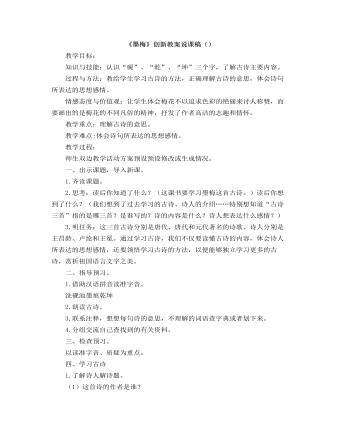
部编人教版四年级下册《古诗词三首》创新教案
二、指导预习。 1.借助汉语拼音读准字音。洗砚池墨痕乾坤2.朗读古诗。3.联系注释,想想每句诗的意思,不理解的词语查字典或者划下来。4.分组交流自己查找到的有关资料。三、检查预习。以读准字音、质疑为重点。四、学习古诗1.了解诗人解诗题。(1)这首诗的作者是谁?(2)《墨梅》作者:元代著名画家王冕。王冕(公元1287——1359)我国元代著名画家。字元章,号煮石山农,诸暨人(今浙江绍兴)。(3)这首诗的题目是什么?(墨梅。这是一首题画诗。墨梅,顾名思义,即为用水墨画的梅花。)(4)从题目上,你知道了什么?还想知道什么?(知道了这首诗写的是水墨画的梅花。想知道这幅梅花图是谁画的?墨梅有什么特点?诗人为什么要写《墨梅》这首诗?要表达自己什么样的感情?)
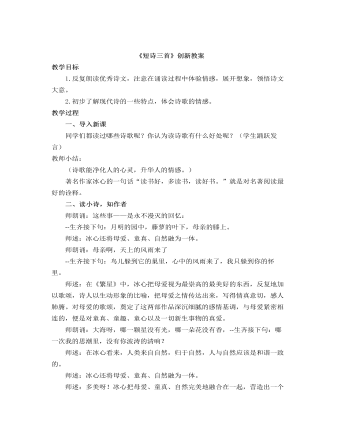
部编人教版四年级下册《 短诗三首》创新教案
教学目标1.反复朗读优秀诗文,注意在诵读过程中体验情感,展开想象,领悟诗文大意。2.初步了解现代诗的一些特点,体会诗歌的情感。教学过程一、导入新课同学们都读过哪些诗歌呢?你认为读诗歌有什么好处呢?(学生踊跃发言)教师小结:(诗歌能净化人的心灵,升华人的情感。)著名作家冰心的一句话“读书好,多读书,读好书。”就是对名著阅读最好的诠释。
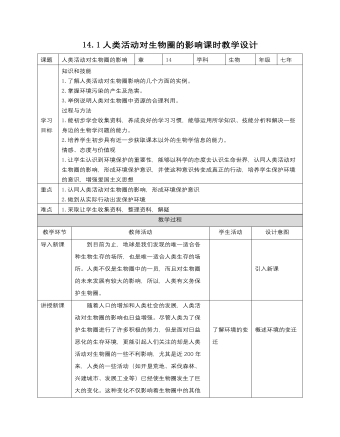
初中生物北师大版七年级下册《第14章第1节人类活动对生物圈的影响》教案
知识和技能 1.了解人类活动对生物圈影响的几个方面的实例。 2.掌握环境污染的产生及危害。 3.举例说明人类对生物圈中资源的合理利用。 过程与方法 1.能初步学会收集资料,养成良好的学习习惯,能够运用所学知识、技能分析和解决一些身边的生物学问题的能力。 2.培养学生初步具有近一步获取课本以外的生物学信息的能力。 情感、态度与价值观 1.让学生认识到环境保护的重要性,能够以科学的态度去认识生命世界,认同人类活动对生物圈的影响,形成环境保护意识,并使这种意识转变成真正的行动,培养学生保护环境的意识,增强爱国主义思想1.认同人类活动对生物圈的影响,形成环境保护意识 2.做到从实际行动出发保护环境1.采取让学生收集资料,整理资料,解疑
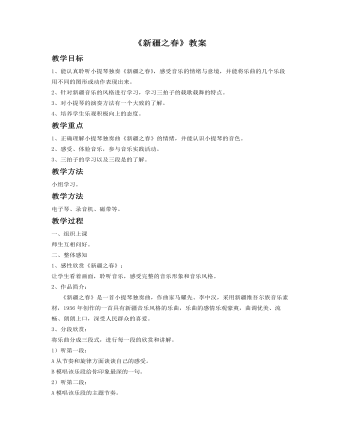
《新疆之春》教案
教学过程一、组织上课师生互相问好。二、整体感知1、感性欣赏《新疆之春》:让学生看着画面,聆听音乐,感受完整的音乐形象和音乐风格。2、作品简介:《新疆之春》是一首小提琴独奏曲,作曲家马耀先、李中汉,采用新疆维吾尔族音乐素材,1956年创作的一首具有新疆音乐风格的乐曲,乐曲的感情乐观豪爽,曲调优美、流畅、朗朗上口,深受人民群众的喜爱。3、分段欣赏:将乐曲分成三段式,进行每一段的欣赏和讲解。1)听第一段:A从节奏和旋律方面谈谈自己的感受。B模唱该乐段给你印象最深的一句。2)听第二段:A模唱该乐段的主题节奏。B体会该乐段出现的小提琴演奏技巧。3)听第三段:让学生知道乐曲中的结束句。4、完整欣赏:1)注意乐曲的整体结构。2)体会乐曲的主题特征和演奏技巧。3)对三段式有一个大致的了解。5、总结:1)新疆音乐风格:旋律、节奏……2)乐曲背景:作者、创作环境……3)小提琴演奏技巧:双音、拨弦……师:春天是一年中最重要的季节,是一年中最美丽的季节。今天我们歌唱了祖国美丽的春天,感受了新疆的美丽春天。让我们珍惜这美好的春天,为创造祖国更美的春天努力吧。
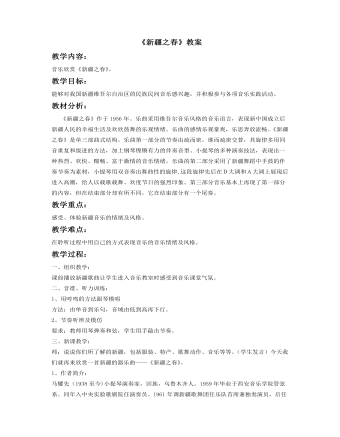
《新疆之春》教案
教学过程:一、组织教学: 课前播放新疆歌曲让学生进入音乐教室时感受到音乐课堂气氛。 二、音准、听力训练: 1、用哼鸣的方法跟琴模唱 方法:由单音到乐句,音域由低到高再下行。2、节奏听辨及模仿 要求:教师用琴弹奏和弦,学生用手敲击节奏。 三、新课教学: 师:说说你们所了解的新疆,包括服装、特产、歌舞动作、音乐等等。(学生发言)今天我们就再来欣赏一首新疆的器乐曲——《新疆之春》。1、作者简介:马耀先(1938至今)小提琴演奏家,回族,乌鲁木齐人。1959年毕业于西安音乐学院管弦系。同年入中央实验歌剧院任演奏员。1961年调新疆歌舞团任乐队首席兼独奏演员,后任乐队队长。作有《新疆之春》等乐曲和歌曲。 李中汉(1933至今)作曲家,河北定县人。1949年入西北艺术学校学习小提琴。1954年考入西安音乐专科学校专修作曲。在校期间合作创作了《新疆之春》等。现在铁道部第一工程局文工团任作曲。作有小提琴曲《欢乐的牧场》、歌剧音乐《帕丽扎特》等。 2、乐曲初听——思考: (1)、这首乐曲的情绪是怎样的? (2)、在这首乐曲主要是用什么乐器演奏的?用什么乐器做伴奏的?(3)、这首乐曲可以分为几个部分? (要求:学生带着问题聆听并思考,乐曲听完后师生共同解决思考题。)

《新疆之春》教案
教学程序:一、创设情境 大屏幕播放歌曲《新疆之春》,学生伴随音乐走进教室。优美的音乐,动人的画面,使人仿佛置身于歌舞之乡——新疆。 (为学生创设轻松、愉快的学习氛围,情境交融,以情诱兴,为学好新课做铺垫。)二、新课导入 列举常见的新疆民族歌舞照片以及习俗。三、整体感知 (1)感性欣赏《新疆之春》 让学生聆听音乐,感受完整的音乐形象和音乐风格。 (初听乐曲,感受音乐,整体把握乐曲的情绪。整体感受是音乐自身规律的体现,也是艺术熏陶饿一个方面的要求,是真正提高音乐素质的有效途径。符合从整体局部的认识规律。体现了音乐教育是以审美为核心,以兴趣爱好为动力的练习,能够引起音乐教育理念。) (2)设置疑问 A、乐曲的音乐风格怎么样?(音调、节奏) B、乐曲用什么乐器演奏的? C、乐曲是采用哪种演奏形式? (根据设置的疑问进行讨论。教师整理归纳:这是一首新疆音乐风格的乐曲,演奏乐器是小提琴,伴奏乐器是钢琴。) (3)作品简介 《新疆之春》是一首小提琴独奏曲,作曲家马耀先、李中汉,采用新疆维吾尔族音乐素材,1956年创作的一首具有新疆音乐风格的乐曲,乐曲的感情乐观豪爽,曲调优美、流畅、朗朗上口,深受人民群众的喜爱。 (4)视唱练习(音乐主题) 引导学生击拍、视唱练习。要求:旋律顺畅、节奏准确,精讲多练,以唱代讲,以唱入境,以唱悟情,最后熟唱乐曲主题。
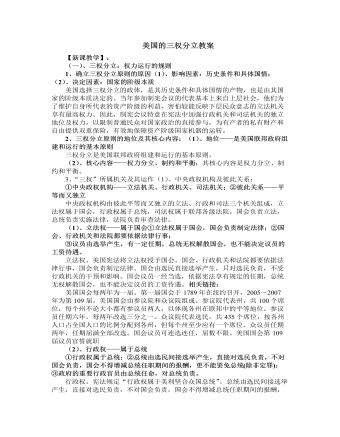
人教版高中政治选修3美国的三权分立教案
国会一直在政治生活中居于主导地位;到了当代,则是总统居于主导地位。由于司法机关无权直接支配社会力量和财富,相比之下,联邦法院力量向来较弱。第二次世界大战后,由于美国一直追逐全球霸权,美国总统的战争权力更加强化,向海外派遣军队的次数更加频繁。美国人民日益觉察到这种不断增长的“帝王般总统职位”可能带来的危险。2、三权分立制的本质——是一种资产阶级民主制度美国的三权分立制本质上是一种资产阶级民主制度。二百多年的历史经验表明,它有效地维护了美国资产阶级的统治。但是,广大劳动人民不可能在这种制度下享有真正的民主。虽然三大权力机关之间互相制约、平衡,却没有一个代表人民意志的权力机关,因而不可能实现人民群众的多数人统治。◇本框题小结:◇3个3种权力:3种权力即立法权、行政权和司法权;3个弊端:即三权分立原则的3 个弊端;3个中央政权机构即立法机关、行政机关和司法机关;◇2个原因:即确立三权分立原则的原因◇1个本质:即三权分立原则的本质
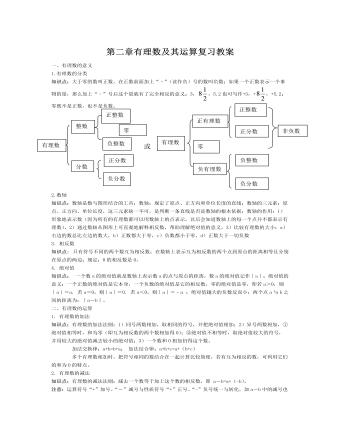
北师大初中七年级数学上册第二章复习教案
. 一个数的倒数等于它本身的数是()A.1 B. C.±1 D.04. 下列判断错误的是()A.任何数的绝对值一定是非负数; B.一个负数的绝对值一定是正数;C.一个正数的绝对值一定是正数; D.一个数不是正数就是负数;5. 有理数a、b、c在数轴上的位置如图所示则下列结论正确的是()A.a>b>0>c B.b>0>a>cC.b<a<0< D.a<b<c<06.两个有理数的和是正数,积是负数,则这两个有理数( )A.都是正数; B.都是负数; C.一正一负,且正数的绝对值较大; D.一正一负,且负数的绝对值较大。7.若│a│=8,│b│=5,且a + b>0,那么a-b的值是( )A.3或13 B.13或-13 C.3或-3 D.-3或-138. 大于-1999而小于2000的所有整数的和是()A.-1999 B.-1998 C.1999 D.20009. 当n为正整数时, 的值是()
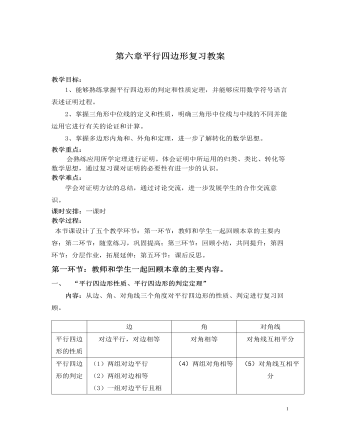
北师大初中八年级数学下册第六章复习教案
解1:设该多边形边数为n,这个外角为x°则 因为n为整数,所以 必为整数。即: 必为180°的倍数。又因为 ,所以 解2:设该多边形边数为n,这个外角为x。又 为整数, 则该多边形为九边形。第二环节:随堂练习,巩固提高1.七边形的内角和等于______度;一个n边形的内角和为1800°,则n=________。2.多边形的边数每增加一条,那么它的内角和就增加 。3.从多边形的一个顶点可以画7条对角线,则这个n边形的内角和为( )A 1620° B 1800° C 900° D 1440°4.一个多边形的各个内角都等于120°,它是( )边形。5.小华想在2012年的元旦设计一个内角和是2012°的多边形做窗花装饰教室,他的想法( )实现。(填“能”与“不能”)6. 如图4,要测量A、B两点间距离,在O点打桩,取OA的中点 C,OB的中点D,测得CD=30米,则AB=______米.
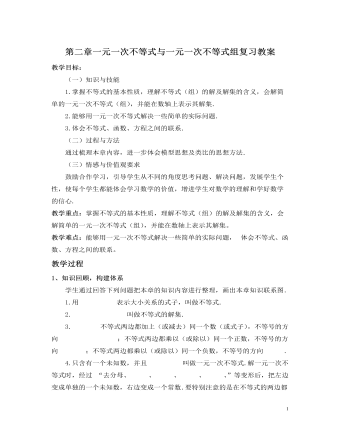
北师大初中八年级数学下册第二章复习教案
例1 解不等式x> x-2,并将其解集表示在数轴上.例2 解不等式组 .例3 小明放学回家后,问爸爸妈妈小牛队与太阳队篮球比赛的结果.爸爸说:“本场比赛太阳队的纳什比小牛队的特里多得了12分.”妈妈说:“特里得分的两倍与纳什得分的差大于10;纳什得分的两倍比特里得分的三倍还多.”爸爸又说:“如果特里得分超过20分,则小牛队赢;否则太阳队赢.”请你帮小明分析一下.究竟是哪个队赢了,本场比赛特里、纳什各得了多少分?例4 暑假期间,两名家长计划带领若干名学生去旅游,他们联系了报价均为每人500元的两家旅行社,经协商,甲旅行社的优惠条件是:两名家长全额收费,学生都按七折收费;乙旅行社的优惠条件是家长、学生都按八折收费.假设这两位家长带领x名学生去旅游,他们应该选择哪家旅行社?
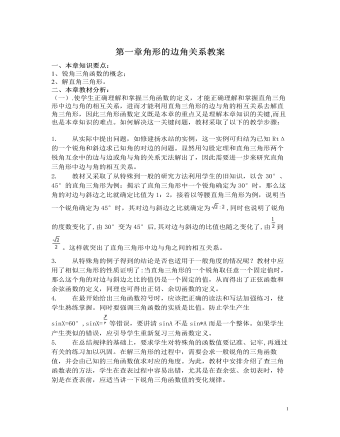
北师大初中九年级数学下册第一章复习教案
一、本章知识要点: 1、锐角三角函数的概念; 2、解直角三角形。二、本章教材分析: (一).使学生正确理解和掌握三角函数的定义,才能正确理解和掌握直角三角形中边与角的相互关系,进而才能利用直角三角形的边与角的相互关系去解直角三角形,因此三角形函数定义既是本章的重点又是理解本章知识的关键,而且也是本章知识的难点。如何解决这一关键问题,教材采取了以下的教学步骤:1. 从实际中提出问题,如修建扬水站的实例,这一实例可归结为已知RtΔ的一个锐角和斜边求已知角的对边的问题。显然用勾股定理和直角三角形两个锐角互余中的边与边或角与角的关系无法解出了,因此需要进一步来研究直角三角形中边与角的相互关系。2. 教材又采取了从特殊到一般的研究方法利用学生的旧知识,以含30°、45°的直角三角形为例:揭示了直角三角形中一个锐角确定为30°时,那么这角的对边与斜边之比就确定比值为1:2。
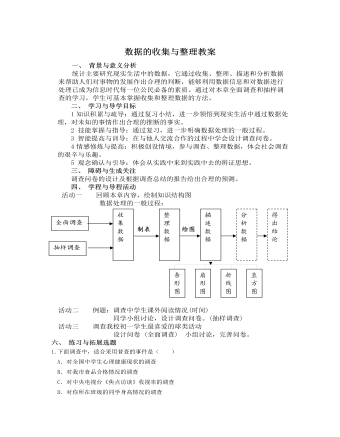
北师大初中七年级数学上册第六章复习教案
一、 背景与意义分析统计主要研究现实生活中的数据,它通过收集、整理、描述和分析数据来帮助人们对事物的发展作出合理的判断,能够利用数据信息和对数据进行处理已成为信息时代每一位公民必备的素质。通过对本章全面调查和抽样调查的学习,学生可基本掌握收集和整理数据的方法。二、 学习与导学目标1 知识积累与疏导:通过复习小结,进一步领悟到现实生活中通过数据处理,对未知的事情作出合理的推断的事实。2 技能掌握与指导:通过复习,进一步明确数据处理的一般过程。3 智能提高与训导:在与他人交流合作的过程中学会设计调查问卷。4 情感修炼与提高:积极创设情境,参与调查、整理数据,体会社会调查的艰辛与乐趣。5 观念确认与引导:体会从实践中来到实践中去的辨证思想。三、 障碍与生成关注调查问卷的设计及根据调查总结的报告给出合理的预测。四、 学程与导程活动活动一 回顾本章内容,绘制知识结构图
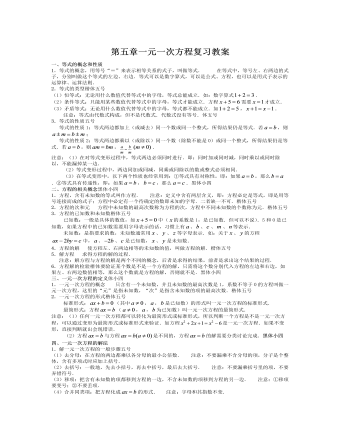
北师大初中七年级数学上册第五章复习教案
16.已知甲组有28人,乙组有20人,则下列调配方法中,能使一组人数为另一组人数的一半的是( ).A.从甲组调12人去乙组 B.从乙组调4人去甲组C.从乙组调12人去甲组 D.从甲组调12人去乙组,或从乙组调4人去甲组17.足球比赛的规则为胜一场得3分,平一场得1分,负一场是0分,一个队打了14场比赛,负了5场,共得19分,那么这个队胜了( )场.A.3 B.4 C.5 D.618.如图所示,在甲图中的左盘上将2个物品取下一个,则在乙图中右盘上取下几个砝码才能使天平仍然平衡?( )A.3个 B.4个 C.5个 D.6个三、解答题.(19,20题每题6分,21,22题每题7分,23,24题每题10分,共46分)19.解方程:2(x-3)+3(2x-1)=5(x+3)20.解方程: 21.如图所示,在一块展示牌上整齐地贴着许多资料卡片,这些卡片的大小相同,卡片之间露出了三块正方形的空白,在图中用斜线标明.已知卡片的短边长度为10厘米,想要配三张图片来填补空白,需要配多大尺寸的图片.
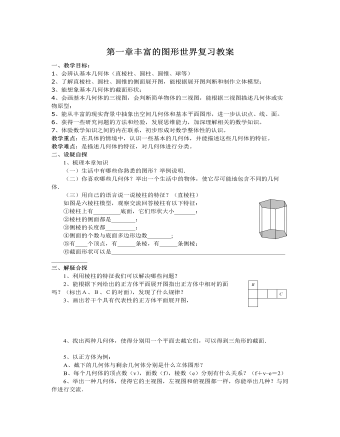
北师大初中七年级数学上册第一章复习教案
一、教学目标:1、会辨认基本几何体(直棱柱、圆柱、圆锥、球等)2、了解直棱柱、圆柱、圆锥的侧面展开图,能根据展开图判断和制作立体模型;3、能想象基本几何体的截面形状;4、会画基本几何体的三视图,会判断简单物体的三视图,能根据三视图描述几何体或实物原型;5、能从丰富的现实背景中抽象出空间几何体和基本平面图形,进一步认识点、线、面。6、获得一些研究问题的方法和经验,发展思维能力,加深理解相关的数学知识。7、体验数学知识之间的内在联系,初步形成对数学整体性的认识。教学重点:在具体的情境中,认识一些基本的几何体,并能描述这些几何体的特征。教学难点:是描述几何体的特征,对几何体进行分类。二、设疑自探1、梳理本章知识(一)生活中有哪些你熟悉的图形?举例说明.(二)你喜欢哪些几何体?举出一个生活中的物体,使它尽可能地包含不同的几何体.(三)用自己的语言说一说棱柱的特征?(直棱柱)
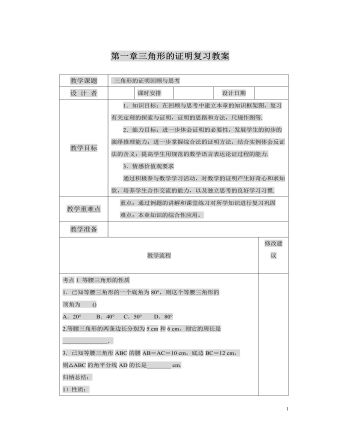
北师大初中八年级数学下册第一章复习教案
1.知识目标:在回顾与思考中建立本章的知识框架图,复习有关定理的探索与证明,证明的思路和方法,尺规作图等.2.能力目标:进一步体会证明的必要性,发展学生的初步的演绎推理能力;进一步掌握综合法的证明方法,结合实例体会反证法的含义;提高学生用规范的数学语言表达论证过程的能力.3.情感价值观要求通过积极参与数学学习活动,对数学的证明产生好奇心和求知欲,培养学生合作交流的能力,以及独立思考的良好学习习惯.重点:通过例题的讲解和课堂练习对所学知识进行复习巩固难点:本章知识的综合性应用。【归纳总结】(1) 定义: 三条边都相等 的三角形是等边三角形。(2)性质:①三个内角都等于60度,三条边都相等②具有等腰三角形的一切性质。
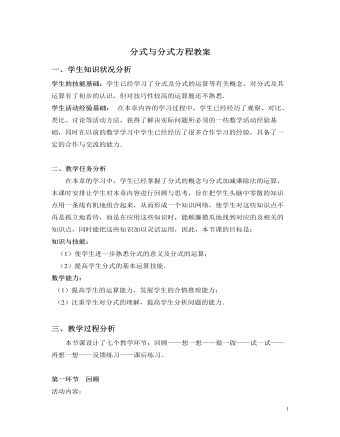
北师大初中八年级数学下册第五章复习教案
教学效果:部分学生能举一反三,较好地掌握分式方程及其应用题的有关知识与解决生活中的实际问题等基本技能.第六环节 课后练习四、教学反思数学来源于生活,并应用于生活,让学生用数学的眼光观察生活,除了用所学的数学知识解决一些生活问题外,还可以从数学的角度来解释生活中的一些现象,面向生活是学生发展的“源头活水”.在解决实际生活问题的实例选择上,我们尽量选择学生熟悉的实例,如:学生身边的事,购物,农业,工业等方面,让学生真切地理解数学来源于生活这一事实。有些学生对应用题有一种心有余悸的感觉,其关键是面对应用题不知怎样分析、怎样找到等量关系。在教学中,如果采用列表的方法可帮助学生审题、找到等量关系,从而学会分析问题。可能学生最初并不适应这种做法,可采用分步走的方法,首先,让学生从一些简单、类似的问题中模仿老师的分析方法,然后在练习中让学生悟出解决问题的窍门,学会举一反三,最后达到能独立解决问题的目的。
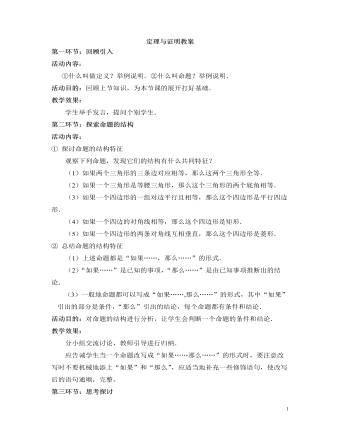
北师大初中数学八年级上册定理与证明2教案
第一环节:回顾引入活动内容:①什么叫做定义?举例说明.②什么叫命题?举例说明. 活动目的:回顾上节知识,为本节课的展开打好基础.教学效果:学生举手发言,提问个别学生.第二环节:探索命题的结构活动内容:① 探讨命题的结构特征观察下列命题,发现它们的结构有什么共同特征?(1)如果两个三角形的三条边对应相等,那么这两个三角形全等.(2)如果一个三角形是等腰三角形,那么这个三角形的两个底角相等.(3)如果一个四边形的一组对边平行且相等,那么这个四边形是平行四边形.(4)如果一个四边的对角线相等,那么这个四边形是矩形.(5)如果一个四边形的两条对角线互相垂直,那么这个四边形是菱形.② 总结命题的结构特征(1)上述命题都是“如果……,那么……”的形式.(2)“如果……”是已知的事项,“那么……”是由已知事项推断出的结论.

幼儿园中班美术教案:神秘印第安人
2、能大胆想象,尝试在废旧纸筒上用多种材料进行制作,体验造型活动的乐趣。 活动准备: 1、有关印第安人的图片、视频。 2、收集各种废旧餐巾纸筒、保鲜膜纸筒、毛线、麻绳、彩纸、边角布料、剪刀、胶棒等。 活动过程: 一、预热阶段 1、老师用故事的形式引出神秘的印第安人,讲述他们特有的生活方式,引起幼儿兴趣。 2、播放印第安人生活和舞蹈的视频,初步了解印第安人原始的生活气息。 二、图形刺激 引导幼儿欣赏、感受印第安人脸部造型和装饰特点。 1、师:你看到的印第安人长得什么样子?他们是怎样打扮自己的? 你觉得什么地方最特别?
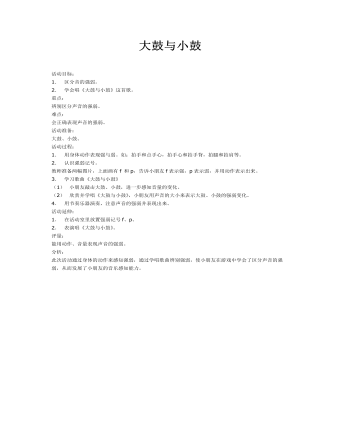
中班音乐教案:大鼓与小鼓
2. 学会唱《大鼓与小鼓》这首歌。 重点: 辨别区分声音的强弱。 难点: 会正确表现声音的强弱。 活动准备: 大鼓、小鼓。 活动过程: 1. 用身体动作表现强与弱。如:拍手和点手心,拍手心和拍手背,拍腿和拍肩等。 2. 认识强弱记号。 教师准备两幅图片,上面画有f和p,告诉小朋友f表示强,p表示弱,并用动作表示出来。

